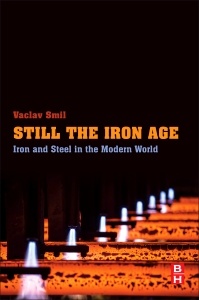Description
Still the Iron Age
Iron and Steel in the Modern World
Author: Smil Vaclav
Language: English
Subject for Still the Iron Age:
Keywords
America's postwar retreat; Atmospheric emissions; Basic oxygen furnaces; Blast furnace; Blast furnaces; Bloomery iron; Charcoal; Charcoal making; Chinese dominance in steelmaking; Coke; Construction; Continuous casting; Dematerialization; Electric arc furnaces; Electricity; Electrostatic precipitators; Energy supply; Expansion and advancement in iron and steel industry; Flows and consumption rates; Fluxes; Fuels; Fuels and electricity; Furnaces; Future steel demand; GDP; Greenhouse gas emissions; Industrial equipment and consumer products; Industry's state; Infrastructure and buildings; Iron ores; Iron smelting; Ironmaking; Japanese dominance in steelmaking; Larger furnaces and hot blast; Life cycle analysis; Material balances; Material substitutions; Modern steel; New blast furnace designs; Pig iron production; Premodern steel; Puddling process; Recycling; Sintering and pelletization; Smelting; Stainless steel; Steel scrap; Steel stocks; Steel uses; Steelmaking; Steelmaking transition; Transition to coke; Transportation; Waste streams; Water use; Wrought iron
Support: Print on demand
Description
/li>Contents
/li>Readership
/li>Biography
/li>Comment
/li>
He has published 35 books and more than 400 papers on these topics. His research areas span throughout the sciences. He is a Distinguished Professor Emeritus at the University of Manitoba, a Fellow of the Royal Society of Canada (Science Academy), and a Member of the Order of Canada. In 2010 he was listed by Foreign Policy among the top 100 global thinkers. He was the first non-American to receive the American Association for the Advancement of Science Award for Public Understanding of Science and Technology.
He has worked as a consultant for many US, EU and international institutions, has been an invited speaker in nearly 400 conferences and workshops in the USA, Canada, Europe, Asia and Africa, and has lectured at many universities in North America, Europe and East Asia. Lastly, in 2013 he had the distinction having Bill Gates state that “There is no author whose books I look forward to more than Vaclav Smil in an article that appeared in Wired.com.
- Incorporates an interdisciplinary discussion of the history and evolution of the iron- and steel-making industry and its impact on the development of the modern world
- Serves as a valuable contribution because of its unique perspective that compares steel to technological advances in other materials, perceived to be important
- Discusses how we can manufacture smarter rather than deny demand
- Explores future opportunities and new efforts for sustainable development in the industry

